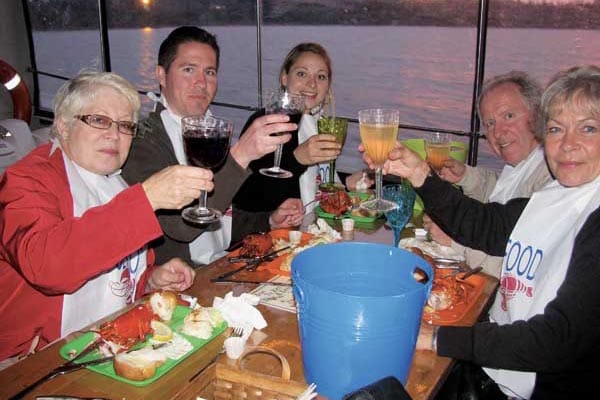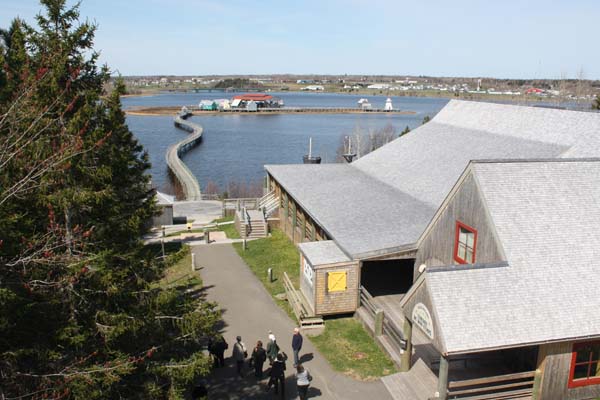A trip aboard a PEI lobster boat offers a unique way to learn about the lobster industry.
“Come aboard!” Captain Mark Jenkins calls from his lobster boat, the Top Notch, which is tied up at the Prince Street wharf in downtown Charlottetown. Eight of us make our way down the ramp, where Mark introduces us to his younger brother, Cody, and helps us down onto the deck. The day is breezy with patchy clouds that threaten rain, but the blue canopy over the boat’s deck and the transparent plastic windows along the sides promise to keep us dry.
Captain Mark is stocky, with thick fisherman’s fingers. He speaks in a confident, measured tone that seems to calm those among us who are new to boating. “On this tour, you’ll learn how lobster fishermen make a living,” he promises. What strikes me about Mark is the dignity with which he conducts himself. There are no airs about the man, just a quiet competence as he prepares for departure.
In contrast, Cody is a ball of energy, dashing to release the bow and stern lines. He pushes the boat off and leaps aboard, quick with an eager smile to help. When he slows down long enough, I ask him if he fishes with his brother. “Yes, we’re a fishing family,” Cody says, with pride. “Six of us fish for a living.” That number includes their brother Scott, sisters Robyn and Gayle, and their father Craig. In addition, Mark’s wife, Patti-Lynn fishes with him, and Mom, Bonnie, fishes with their dad.

“I’m a lobster fisherman”
Mark starts the tour by declaring: “I’m a lobster fisherman. That’s what I do for a living. I’ve been doing it for 20 years and I’m a fourth generation fisherman.” When they’re not running Top Notch Charters from July 1 to mid-September, they fish out of Fortune, PEI. Seventy per cent of Mark’s livelihood comes from the lobster he lands during the two month season, May and June. He and his family still cut their own lumber to build traps in the same way his grandfather did. Cody says, “We’re his apprentices, you might say,” and laughs.
The first buoy comes into view. Mark holds out the gaff—a pole with a hook on the end used to snag the buoy from the water—and asks, “Who wants to give it a try?”
I volunteer, hoping against an embarrassing miss. Mark steers the boat at the buoy as if to run it over, but the buoy slips along the side of the boat. I make a swipe for it, luckily hooking it the first time. The others cheer.
This first trap is loaded with rock crab. Mark holds one up so it can’t pinch him and explains that the rock crab fishery provides a secondary income for lobster fishermen. More importantly, they’re the primary food for lobster. He hands the crab to me. The shell is cold and very hard. When I turn it upside down, the crab clutches its two big claws to its body for protection. I return the crab to the trap. Mark closes it up and pushes it overboard.
Out of the next trap, Mark pulls a male and a female lobster. He gives a fascinating account of lobster biology, explaining how they molt, and describing their amazing ability to reproduce lost body parts. It takes a lobster about seven years to grow to the commercial size of just under a pound, he says, and the rule of thumb is that it takes three years to add each pound of weight after that first seven years.
Poor man’s food
“Lobsters were considered a poor man’s food,” Mark explains. “My grandfather was a farmer and a fisherman. He used to spread lobsters on the field for fertilizer.” Things hadn’t changed much by the time Mark’s father came along. “My father had to take lobster sandwiches to school. He’d get teased, so he’d stop along the way and either eat the lobster or pick it out and fire it into the woods. It was better to show up with a plain bread and butter sandwich.” Today, a license his father would have paid less than dollar for is worth up to half a million dollars. The industry itself is worth more than $100 million annually to the PEI economy, and employs more than 5,000 people.
From the last trap, Mark pulls a six-pound male lobster he’s nicknamed Larry. At Mark’s invitation, I hold the beast, wary of its powerful, six-inch claws. “It could break a child’s hand,” he says. But I have little to worry about. Out of the water, the claws are so heavy, Larry has trouble lifting them.
Finally, our morning tour is over and we head back to Charlottetown. An on-board lobster supper comes with the longer afternoon and evening tours. Sometimes Mark even arranges for a fiddler to serenade his evening guests. “We’re anchored about 20 yards from shore. We got those beautiful red cliffs. Where else in the world can you do this—learn how to catch a lobster, shell it and eat it on board, right from the source?”
But this is the morning tour, and we’re happy just to hear more of Mark’s riveting stories. The rain has held off and the sun sparkles off the water. As Mark skilfully manoeuvers past a dozen sailboats racing our way, we all agree—we’ve had what’s proven to be a “top notch” excursion.



